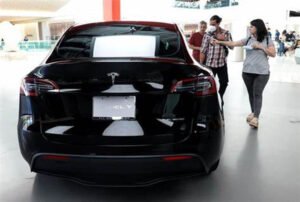
Teslas FSD 5 Key Safety Concerns. Tesla’s Full Self-Driving System Faces NHTSA Scrutiny: Key Questions and Safety Concerns
Tesla’s Full Self-Driving (FSD) system has captured public attention and sparked a range of safety concerns. The National Highway Traffic Safety Administration (NHTSA) recently launched a formal investigation into Tesla’s FSD technology, bringing to light potential issues with the system’s ability to safely navigate real-world driving conditions. The ongoing investigation is addressing key safety concerns as well as Tesla’s promotional strategies, which some argue might give drivers a misleading impression of FSD’s true capabilities. Teslas FSD 5 Key Safety Concerns
Here, we explore the current state of Tesla’s FSD system, its challenges, and the significant questions raised by regulators.
Tesla’s Stock Soars Amid Expectations for FSD Growth
Tesla’s stock value has skyrocketed, largely driven by investor confidence in the potential of its autonomous driving technologies. With a market capitalization exceeding $1 trillion, Tesla’s growth is linked not only to its electric vehicles (EVs) but also to the broader promise of autonomous transport.
Market Influence: Tesla’s advancements in FSD technology have positioned it as a leader in both the EV market and the autonomous vehicle sector.
Musk’s Connections: Investors also believe CEO Elon Musk’s influence could expedite regulatory approvals, potentially putting Tesla’s Robotaxi vision on the fast track.

NHTSA’s Concerns About FSD Safety
The NHTSA’s investigation covers more than 2 million Tesla vehicles equipped with FSD, focusing on multiple reported accidents, including one fatal collision in 2023. This investigation highlights crucial concerns regarding the system’s safety in specific driving environments, especially under conditions where visibility is compromised.
Reasons Behind the Investigation
Crash Reports: The NHTSA is examining FSD’s performance in accidents involving Tesla vehicles in poor visibility conditions such as dust, fog, and sun glare.
Performance and Limitations: The agency is seeking to understand if the system adequately alerts drivers when it can no longer safely operate.
The December Deadline for Tesla’s Response
The NHTSA has asked Tesla to provide answers by December 18, 2024. Key areas of inquiry include FSD’s ability to detect hazards and respond to road conditions with limited visibility.
Investigation Scope: This includes examining the feedback provided to drivers and how the system communicates when it reaches its performance limits.
Driver Responsibility: Regulators are also assessing whether Tesla has done enough to ensure drivers remain engaged and ready to intervene when necessary.
Accidents Under Scrutiny
The investigation’s focus has sharpened due to multiple collisions where FSD’s limitations became apparent. One fatal accident in Arizona involved a driver using FSD in bright sunlight when visibility was significantly reduced. The vehicle tragically struck and killed a pedestrian, raising serious questions about FSD’s detection capabilities under adverse conditions.
Incident in Rimrock, Arizona
Driver Reliance on FSD: The driver reportedly relied on FSD to navigate, even as glare obstructed visibility.
System’s Limitations: This incident underscores concerns about whether FSD can detect pedestrians and other obstacles in difficult lighting situations.
Tesla’s Claims and Potential Overstatements of FSD’s Capabilities
Tesla’s marketing, often highlighted on X (formerly Twitter), has emphasized the convenience of FSD, sometimes suggesting that the system can handle all aspects of driving. The NHTSA has noted that such posts might unintentionally encourage drivers to overestimate FSD’s abilities.
Social Media Influence
Promotional Videos: Posts showing users relying on FSD during medical emergencies or long drives might convey that Tesla vehicles are fully autonomous.
Regulatory Concerns: The NHTSA worries that these messages could mislead drivers, creating a perception that FSD requires less oversight than it actually does.
FSD and Driver Attention
Tesla advises drivers to stay vigilant while using FSD, as the system is not fully autonomous. The company’s manuals specify that drivers must remain attentive and ready to take control if necessary. Yet, studies suggest that drivers often fail to heed these warnings.
Distracted Driving Risks
Driver Inattention: The Insurance Institute for Highway Safety (IIHS) published a study in September revealing that drivers frequently misuse semi-autonomous systems.
System Bypasses: Some Tesla drivers have reportedly found ways to bypass FSD’s safeguards, allowing them to become distracted while the system is active.
NHTSA’s Analysis: Is Tesla Doing Enough?
The NHTSA’s investigation will also consider the adequacy of FSD’s feedback to drivers. This includes assessing whether the system’s alerts and messages adequately inform drivers when manual control is necessary.
Key Investigation Points
Real-Time Alerts: Regulators are evaluating whether Tesla’s notifications sufficiently prompt drivers to intervene when FSD performance drops.
Driver Misunderstandings: The NHTSA seeks to determine if FSD’s design and Tesla’s messaging might unintentionally cause drivers to over-rely on the system.
The Future of FSD: Questions for Tesla and Musk
As Tesla continues to advance its FSD technology, the company faces mounting pressure to address the NHTSA’s concerns. The agency’s questions hint at broader issues related to autonomous driving, safety.
Key Concerns Moving Forward
System Reliability: The NHTSA is focusing on whether FSD can perform reliably across varying weather conditions.
Transparency with Drivers: Clearer communication about FSD’s capabilities and limitations is crucial to preventing over-reliance.
Why Transparency Matters in FSD Development
As FSD technology develops, transparency from Tesla is vital. Customers need to understand both the strengths and limitations of this technology. The NHTSA’s current probe could lead to stricter regulatory standards for FSD and similar systems, particularly regarding how they are marketed to the public.
Conclusion: The Road Ahead for Tesla’s FSD Technology
Tesla’s FSD system stands at a critical juncture. With an investigation underway and the NHTSA’s deadline looming, Tesla faces increasing pressure to prove that FSD is not only effective but safe for all drivers. Whether Tesla can meet these demands will shape not only the future of its FSD technology but also the wider landscape of autonomous vehicles.
The results of the NHTSA’s investigation could lead to significant changes, both for Tesla and for the regulatory framework around autonomous driving systems. For now, Tesla drivers should remember that FSD is a tool that still requires their attention and intervention.
This ongoing inquiry highlights the complex relationship between innovation, safety, and accountability in the rapidly evolving field of autonomous driving.







